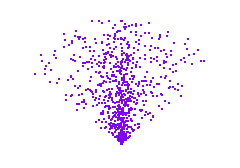The particle render type of a particle object specifies the form of its particles. For example, you can display particles as small spheres, streaking tails, or 2D images of your favorite snapshot. Once you select the particle render type, you can add attributes specific to the render type to tune the appearance.
For information on hardware and software rendering of particles, see Rendering particles.

To set the Particle Render Type
Workspace preview rendering doesn’t display render types with full detail. You must hardware render or software render. Turn on Shading > Smooth Shade All if you want workspace rendering to display color that you add to particle objects.
When you test render or render to disk, use hardware rendering for the particle render types that don’t have s/w after their names. Blobby Surface, Cloud, and Tube must be software rendered. If you use the wrong rendering technique, the particles won’t be displayed. If you use hardware rendering, you must composite the particle images with software rendered images of the other objects in the scene.
You must apply a material with shading group to the particle object. Tube (s/w) and Cloud (s/w) render types use specific particle cloud materials. You can use any surface material with Blobby surface render type.
The Points render type displays particles as points. This is the default render type.

The MultiPoint render type displays each particle as multiple points. The extra points make the particle object appear denser. You can use this render type to create dust, clouds, mist, or other gaseous emissions.

The Streak render type displays moving particles with an elongated tail. This render type enhances the display of objects such as meteors or rain. The streak length is based on the velocity of the particle, so if the particles are stationary or moving slowly, you won’t see the particles.

The MultiStreak render type is a combination of Streak and MultiPoint render types; it displays multiple points with tails for each moving particle. The faster the particles move, the longer the tails.

To set MultiStreak render type
The Sprites render type lets you display a texture image or image sequence at each particle. Each particle can display an identical or different image or image sequence. Depending on the type of texture image you use, you can use sprites to create effects such as smoke, clouds, fog, and stars.
A sprite appears as a small rectangle until you map a texture image to it. The image faces the camera directly regardless of the camera’s position or orientation.
If the texture image lacks an alpha channel, the image is opaque and occupies the sprite rectangle. If the texture image has an alpha channel, the sprite uses the image’s transparency. To avoid displaying the rectangle, you must make the peripheral parts of the original texture image transparent.
The particle Sprite Wizard simplifies the process for displaying a texture image or image sequences on particles. The particle Sprite Wizard leads you through the steps necessary to associate image files with sprites. You can assign a single image or a sequence of images to each particle. The images can be assigned randomly, or using various criteria such as the particleID or a ramp. You can also edit the sprites once you’ve created them with the Sprite Wizard.
The Sprite Wizard automatically:
The Sprite Wizard leads you through a series of choices. For help, read the pop-up help that appears with each text box.
For additional information on the Custom Start and Custom Cycling options, see Customizing sprites with the Sprite Wizard.
To change the images of an existing sprite animation:
All the existing settings in the Sprite Wizard are used with the new image sequence.
Once you have created the sprites, you can optionally edit these Render and Sprite attributes in the Attribute Editor or in the Channel Box:
You can customize how the initial sprite images are selected and how the images are cycled by modifying the expressions that are automatically added to the particle object when you use the Sprite Wizard. You can customize the selection of the initial sprite image whether or not you choose to animate the selection of the initial image.
To customize the selection of the initial sprite image
If you selected Cycle through the images for each particle for the image assignment, look for the second occurrence of the line “Custom Start: If your sprites are animated” in the creation expression.
The Spheres render type displays particles as opaque spheres. You cannot display the spheres with transparency.

The Numeric render type displays the current values of any attribute of the particle object. This is useful when you want to know the value of an attribute such as velocity at a certain frame. By default, Maya displays particle ids for the Numeric render type.

The Blobby Surface render type displays particles as metaballs. Metaballs are spheres that blend together to form surfaces. Blobby Surfaces appear only in software rendered images.

To avoid this, you can increase the particle rendering quality by selecting the particle object and making the following render settings. Open the Maya Software tab of the Render Settings window. Under Number of Samples, set Particles to 4, or to achieve very high quality particle rendering, set Particles to 8.
To set Blobby Surface (s/w) render type
The Cloud render type displays particles as blurred or cloudy metaballs. Metaballs are spheres that blend together to form surfaces. Clouds appear only in software rendered images. See Create raytraced shadows with particles.

To set Cloud (s/w) render type
The Tube render type displays particles as tubes. Tubes appear only in software rendered images.

 Except where otherwise noted, this work is licensed under a Creative Commons Attribution-NonCommercial-ShareAlike 3.0 Unported License
Except where otherwise noted, this work is licensed under a Creative Commons Attribution-NonCommercial-ShareAlike 3.0 Unported License